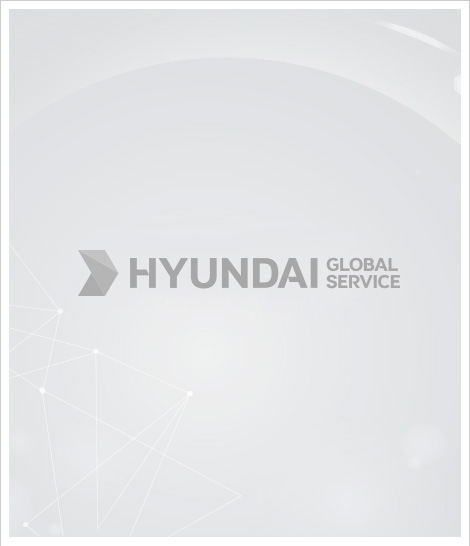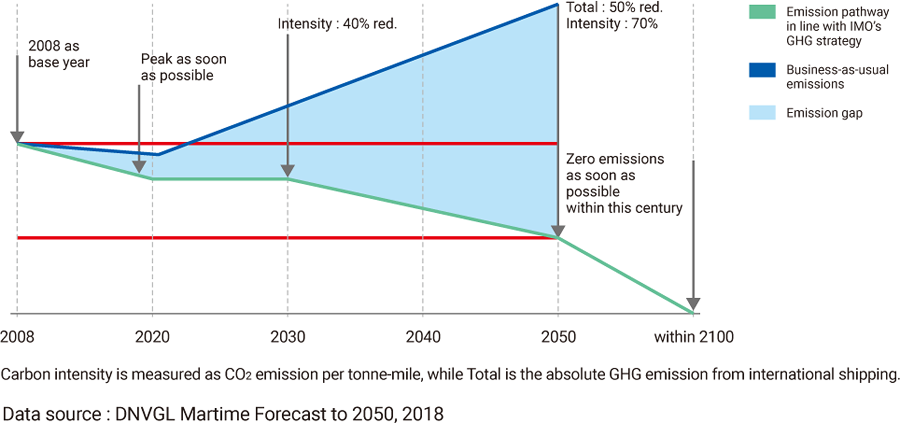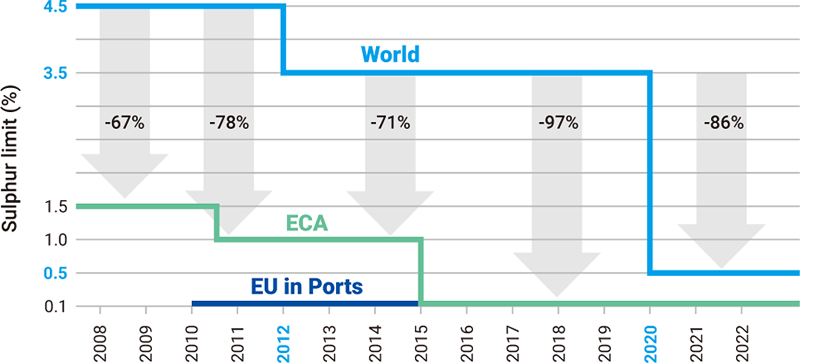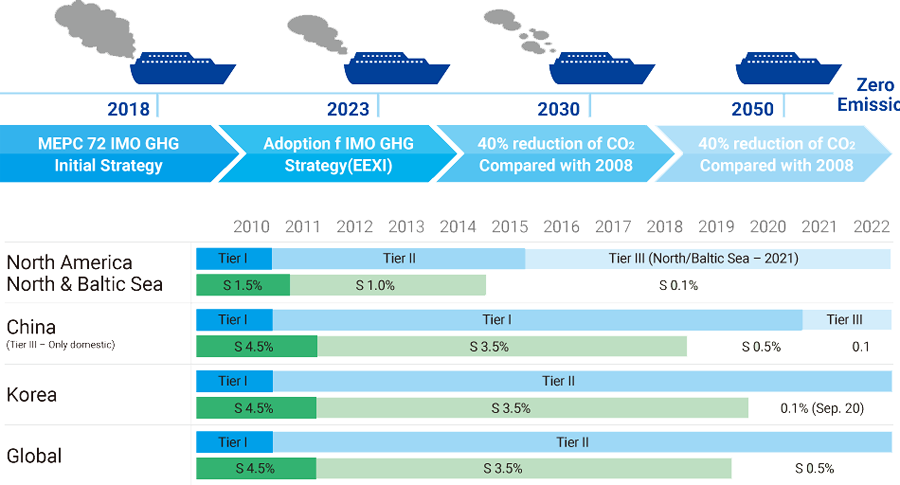
Environmental Regulation
Regulation for GHG Emissions
The initial IMO strategy for reduction of GHG emissions from ships are finalized and adopted.
Reduction per transport, as an average across international shipping, at least 40% by 2030, pursing effort towards 70% by 2050, as compared to 2008.
Reduce the total annual GHG emissions at least 50% by 2050 as compared to 2008.
The adoption of revised IMO strategy will be decided at the MEPC 80th meeting (Spring, 2023)
GHG Emissions
Regulation for SOx Emissions
MAROL revision banning of loading HFO (higher than 0.5% Sulfur oil) on the scrubber unequipped vessel was opted.
According to the sulfur cap regulation decided by the MEPC(Marine Environment Protection Committee) at October 2016, Global marine fuel’s sulfur content standard has been enhanced from 3.5% to 0.5% since January 2020.
Shipbuilding & Marine industry has to select the solutions such as Scrubber, LNG retrofit, or using low sulfur fuel oil to meet the regulation, ahead of the implementation of the most powerful global environmental regulation.
Scrubber fitted vessel is only permitted to use high sulfur fuel otherwise, it is highly prohibited to load high sulfur fuel on board. HGS has been providing customer-oriented service to meet every customers needs
by expanding business area not only supply and installation of Scrubber but also LNG retrofit and suppling low sulfur fuel from bunkering service which take over at June 2016.
Regulation for NOx Emissions
The NOx control requirements of Annex VI apply to installed marine diesel engine of over 130 kW output power other than those used solely for emergency purposes irrespective of the tonnage of the ship onto which such engines are installed.
Definitions of ‘installed’ and ‘marine diesel engine’ are given in regulations 2.12 and 2.14 respectively. Different levels (Tiers) of control apply based on the ship construction date, a term defined in regulations 2.19 and hence 2.2,
and within any particular Tier the actual limit value is determined from the engine’s rated speed :
Touch Scroll
| Tier |
Ship construction date on or after |
Total weighted cycle emission limit (g/kWh)
n = engine’s rated speed (rpm) |
| n < 130 |
n = 130 - 1999 |
n ≥ 2000 |
| I |
1 January 2000 |
17.0 |
45·n(-0.2)
e.g., 720 rpm – 12.1 |
9.8
|
| II |
1 January 2011 |
14.4 |
44·n(-0.23)
e.g., 720 rpm – 9.7 |
7.7 |
| III |
1 January 2016 |
3.4 |
9·n(-0.2)
e.g., 720 rpm – 2.4 |
2.0 |
Touch Scroll
| Tier |
Ship construction date on or after |
Total weighted cycle emission limit (g/kWh)
n = engine’s rated speed (rpm) |
| n (rpm) < 130 |
130 ≤ n < 2000 |
n ≥ 2000 |
| I |
1 January 2000 |
17.0 |
45·n(-0.2)
e.g., 720 rpm – 12.1 |
9.8 |
| II |
1 January 2011 |
14.4 |
44·n(-0.23)
e.g., 720 rpm – 9.7 |
7.7 |
| III |
1 January 2016 |
3.4 |
9·n(-0.2)
e.g., 720 rpm – 2.4 |
2.0 |
NOx Reduction Solutions
The solution to meet the nitrogen oxide emission limit is
low pressure LNG propulsion ships, electric propulsion ship, fuel-cell propulsion ship, hybrid ship, nuclear propulsion ship, EGR (Exhaust Gas Recirculation), SCR (Selective Catalytic Reduction), etc.
 HGS-COM-SL-19-002 Periodical Testing of Cooling Water_Laby®-GI Fuel Gas Compressor
HGS-COM-SL-19-002 Periodical Testing of Cooling Water_Laby®-GI Fuel Gas Compressor HGS-MAN-SL-19-002 Accumulators - All Makes, Brands and Types in the Hydraulic System
HGS-MAN-SL-19-002 Accumulators - All Makes, Brands and Types in the Hydraulic System HGS-HSM-SL-19-005 Change of Assembly Procedure of Set Screw for Swing Arm Shaft
HGS-HSM-SL-19-005 Change of Assembly Procedure of Set Screw for Swing Arm Shaft HGS-HSM-SL-19-006 Corrosive Damage of the Exhaust Gas Passage in Cylinder Head
HGS-HSM-SL-19-006 Corrosive Damage of the Exhaust Gas Passage in Cylinder Head

 HGS-BWTS-SL-19-001 Notice of Changing Solnoid Valve Type in TRO Sampling Line
HGS-BWTS-SL-19-001 Notice of Changing Solnoid Valve Type in TRO Sampling Line
 HGS-HSM-SL-19-002 Lubricating Oil Guidance for HiMSEN DF Engines
HGS-HSM-SL-19-002 Lubricating Oil Guidance for HiMSEN DF Engines HGS-MAN-SL-19-001 PMI Sensor Calibration Requirements
HGS-MAN-SL-19-001 PMI Sensor Calibration Requirements
 HGS-WIN-SL-19-001 Instruction for Implementation of Water Guide Jacket “C-clamp
HGS-WIN-SL-19-001 Instruction for Implementation of Water Guide Jacket “C-clamp











